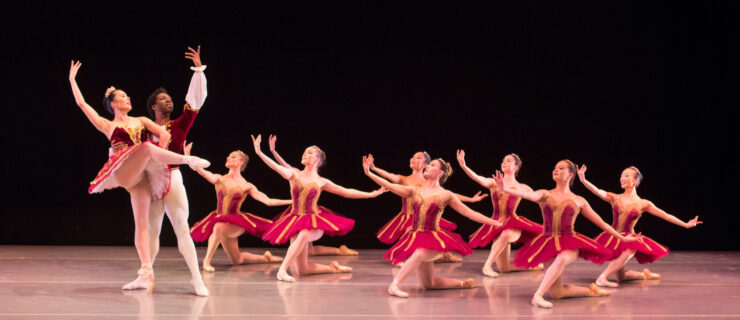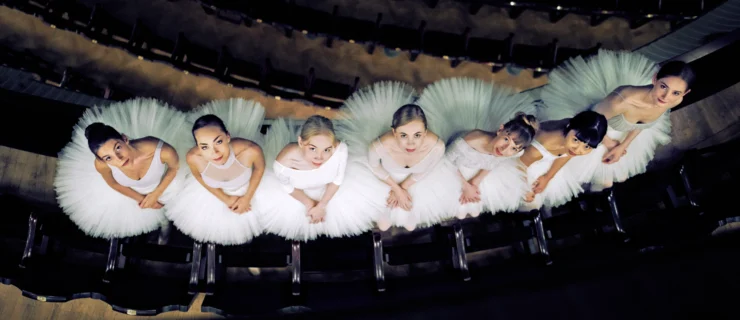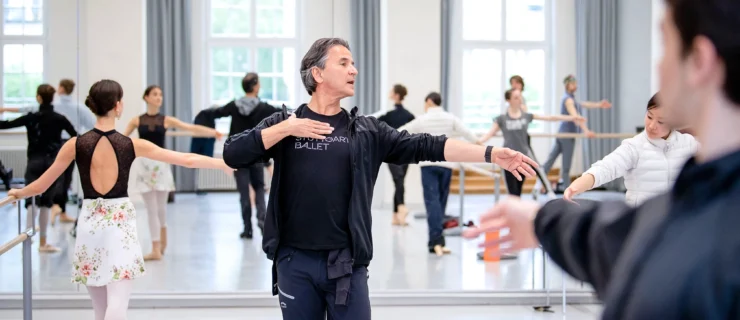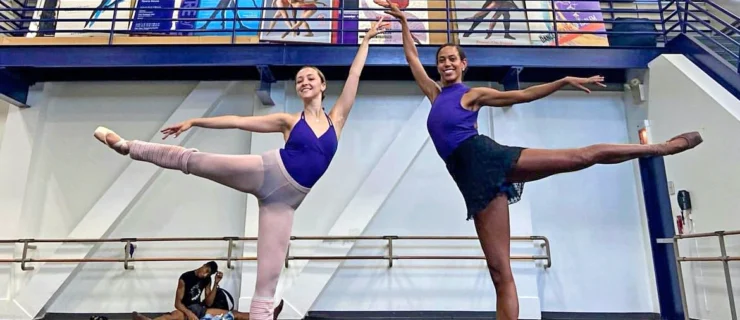Miami Rhapsody
“The company is on such a high,” says Miami City Ballet principal Mikhail Ilyin, referring to the passionate, ebullient dancing that has characterized recent performances. A wide-ranging repertoire, huge performance schedule, a growing roster of international dancers and solid financials are propelling MCB to new levels. Next, the company, which recently wrapped up its 20th anniversary season, is poised to inaugurate the brand-new, $446 million Miami Performing Arts Center this fall as one of four resident arts organizations. But getting to its current enviable position hasn’t been easy. From the beginning, Artistic Director Edward Villella has planned carefully and far in advance, eschewing easy triumphs in favor of the slow, steady artistic progress that builds a company but doesn’t make headlines. Yet when asked what he’s most proud of after 20 years, Villella says simply, “That we’ve survived.”
Villella accepted the job of artistic director of the yet-to-be-formed Miami City Ballet in 1985, after retiring from a legendary 18-year performing career with New York City Ballet. Known for his athleticism and masculinity as well as his cocky wit, he had excelled in Balanchine ballets, such as Prodigal Son and “Rubies” as well as Jerome Robbins’ lyrical Dances at a Gathering. “I had the great privilege to work with the greats of the 20th century,” he says, including impresario Lincoln Kirstein as well as Balanchine and Robbins. “There was a wonderful knowledge that was passed on to me.”
From the start, Villella took a long-term approach, writing an 11-and-a-half-year plan that incorporated 18 months of preparation and set-up, followed by three-, five- and 10-year production plans, complete with budgets. Before the company even stepped onstage, Villella had five years of programming planned.
For its first 10 years, the focus was mainly, but not entirely, on what Villella knew best—the Balanchine repertoire. “I did it all in reverse,” he says. “Most people start with the well-known classics to attract audiences. I decided to approach the most elusive and difficult of the masters of style, that, of course, being Balanchine.”
Villella’s analytical approach to repertoire development even extended to the order in which he acquired the Balanchine ballets. The company first mastered the more straightforward Allegro Brillante and Serenade and worked up to the challenges of the complex Four Temperaments, Agon and Jewels. Villella built Jewels one section at a time, only later presenting it in its full-evening form.
The company turns in distinctive performances of the Balanchine rep, because Villella takes care that the dance interpretations are properly nurtured. For Jewels, he brought in the original dancers to coach the different sections: Violette Verdy for “Emeralds,” Patricia McBride for “Rubies” and Suzanne Farrell for “Diamonds.”
That philosophy was what attracted some of MCB’s current dancers. Ilyin, who trained at Russia’s Vaganova school and danced with Boston Ballet, auditioned for MCB specifically because he wanted to work with Villella. “I was interested in learning the American style of neoclassical ballet from someone who danced with NYCB and had roles created for him by George Balanchine,” he says. “Villella’s not just giving us background stylistically and stepwise, but also what the intention of the choreographer was.”
For his part, Villella selects dancers by focusing on the individual. “The first thing I look for is quality of movement. Each of us has that singular fingerprint of how we move,” he says. “The second is how we move to music and if we have the ability to physicalize music.” And while Villella also looks for “compatible, willing human beings,” he believes that an important factor in developing a company is “that people have artistic information that is common throughout the ranks.”
To further this goal, Villella teaches company class every day, so that his singular approach can create a more unified look for a company made up of dancers from more than a dozen countries. He hires young dancers, often early in their careers, and promotes from the corps de ballet. “We are not a company that hires or rents superstars,” he says. “We develop from within. It’s part of my great satisfaction to look at young kids who came here straight out of schools and academies and are now principal dancers.”
Mary Carmen Catoya, a principal dancer from Venezuela, had seen Villella dance on video and was thrilled to be able to work closely with a star of the ballet world who was also accessible and approachable. “What makes it special is that we all feel like family,” she says. “Our director always wants the dancers to be happy and feel comfortable. He’s respectful of who you are as a human being.”
Villella credits the congenial atmosphere in part to the company’s extensive performance schedule. In addition to moving from the Jackie Gleason Theater in Miami Beach to the new Miami Performing Arts Center, the company will continue performing at three South Florida venues: the Broward Center in Ft. Lauderdale, the Kravitz Center in Palm Beach and the Naples Philharmonic. With the Florida dates and extensive national and international touring, up to five different casts for each ballet get an enormous amount of stage time for a company of its size. “You perform a lot, and that’s what makes a dancer. I love to dance; that’s why I’m here,” says Catoya.
“When dancers have opportunities, it eliminates—to put it delicately—interpersonal problems,” says Villella. “We have challenged our younger dancers with opportunity, and they have responded. And that, I think, has been a tremendous help in terms of the artistic development and growth of our company.”
In the early days, however, in addition to building the rep and developing dancers who could make it soar, Villella also had to convince Floridians that neoclassical ballet was something they needed to see. “This was not what you would call a cultural destination 20 years ago,” he says dryly. “It was interesting to compete with sun and sand and clubs and tourism. To say that [Balanchine] was an easy sell in Florida—no. It was very difficult and people resisted. To a certain degree, they still do.” To combat audiences’ uneasiness with the unfamiliar, Villella began speaking before performances (a practice he continues), discussing the ballets’ styles, musical qualities and technical considerations, as well as the elusive drama and emotion in Balanchine ballets.
The challenges of promoting ballet in South Florida extended to the company’s finances as well. MCB started with a budget of $1 million and 19 dancers and has grown to $10.5 million with the hope of expanding to $12.5 million and more than 50 dancers for the 2006-07 season.
The company experienced many lean years. In 1992, Hurricane Andrew blew out studio windows and devastated the company’s costume shop. “Nothing happened in this city for three months, so we couldn’t draw an audience, and that provided deficit,” says Villella. “And once you achieve a deficit, boy, it’s yours to keep.” The economic aftereffects of 9/11, the dot-com bust and last year’s multiple hurricanes combined to set the company, which earns 55 percent of its revenue from the box office, further behind.
MCB was able to climb out of that hole with the help of the City of Miami Beach, which had given the company the land and $2.5 million to build a beautiful 63,000-square-foot facility in Miami Beach in 2000. Skyrocketing real-estate prices raised the property’s value, making it possible earlier this year for the city to come to the rescue with $5.3 million in exchange for ownership of the building, which it now rents to the company for one dollar per year. “That literally saved us,” says Villella.
Out of gratitude to the City of Miami Beach, Villella created a new contemporary series and children’s programming in the facility’s 250-seat theater, as the move to the new Miami Performing Arts Center meant that the company would no longer have any scheduled performances in Miami Beach.
“I think the contemporary series can and should work well on the Beach, because the Beach is a younger crowd,” says Villella. He hired David Palmer and Yannis Pikieris, former MCB dancers who had spent the past eight years working on a contemporary dance company called Maximum Dance, to develop contemporary programming.
The company’s ambitious plans for the upcoming season include a new full-length Don Quixote, as well as Twyla Tharp’s In the Upper Room, Christopher Wheeldon’s Liturgy, Antony Tudor’s Lilac Garden and revivals of Agon, Symphony in Three Movements, Raymonda Variations and Afternoon of a Faun. And, after eight years of dancing mainly to taped music, the company ended its 20th anniversary season performing again to live music.
MCB owes its success to Villella’s dedication and planning, but when asked to compare his career as a dancer to his career as an artistic director, Villella laughs: “If I had the devil’s 800 number, I’d be a dancer again.” The 69-year-old director is equally jocular about the prospect of retirement. “My wife wouldn’t know what to do with me,” he says. True to form, he’s still planning ahead. “I’d like to make five-year plans and take another look at them every three years and adjust the goals,” he says. “I try to challenge everyone slightly beyond their grasp. The whole purpose of this is to move forward. The moment you’re satisfied, it’s over.”





